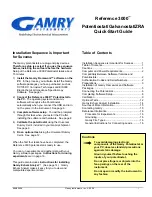INFICON
Introduction | 4
074-594-P1H Micro GC Fusion Operating Manual
25 / 319
displayed with the detector response on the y axis and retention time of the separated
compound on the x axis. The chromatogram provides qualitative and quantitative
information about the injected sample.
Component identity is determined by its retention time in a GC analysis. Retention
time measures the time interval between injection and the detection of a component.
The less retentive the column coating is to a specific compound, the faster that
compound will travel, resulting in shorter retention times. Components that are more
retentive to the column will travel slower, resulting in longer retention times. A
calibration standard with compounds at known concentrations is necessary to
determine the retention times of the target compounds. Using the same analytical
conditions, an unknown sample is then injected into the GC to determine its
composition based on the pre-determined peak retention time.
Quantitation of the target compounds in a GC analysis can be obtained by measuring
the corresponding peak area presented in a chromatogram. The peak area is
proportional to the analyte concentration detected and can be obtained by integrating
the peak. The target compound concentration may be obtained by creating a
calibration curve using calibration gases. Micro GC Fusion uses peak area to quantify
target compound concentration.
Micro GC Fusion embedded chromatography software controls the GC and performs
data analysis. Operation may be controlled directly from the front panel display. A
web-based user interface can be accessed by computers connected through Ethernet
or Wi-Fi on commerically available web browsers.
Micro GC Fusion can also be controlled using INFICON EZ IQ or Agilent CDS
OpenLab EZChrom software. See EZ IQ or OpenLab EZChrom Instrument Control
[


















